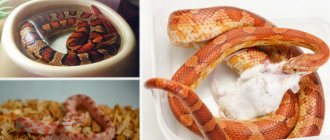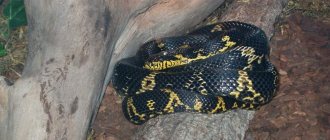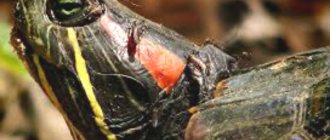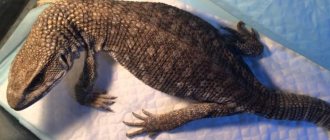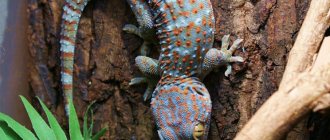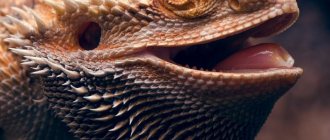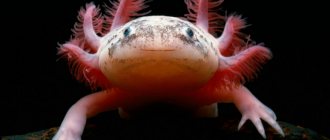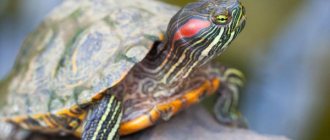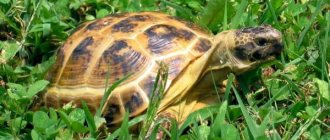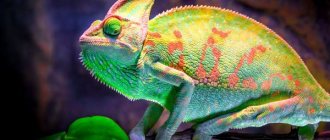The snake is probably one of the most popular snakes to keep at home. Our Panteric nursery breeds a wide variety of corn snakes. They differ in color variations and even the number of scales; in breeding there are completely bald individuals.
The snakes are not large, their size does not exceed 1.5-2 meters. They are slender, graceful snakes, have a friendly and calm disposition, are easy to care for and are ideal as a first snake for beginners.
The corn snake lives in America - from New Jersey to Florida and west to Texas. They can be found in forest clearings, crop fields, even in abandoned or rarely used buildings or farms. Snakes mainly live on the ground, but can climb trees and other heights.
Snakes are active at night or in the pre-dawn hours; during the day they prefer to hide in shelters.
Maintenance equipment:
- For an adult snake, a horizontal or cubic terrarium with dimensions of 45×45×45 cm or 60×45×45 cm is suitable; young animals can be kept in temporary plastic boxes or small terrariums measuring 30×30×30 cm.
- For proper absorption of food, the snake requires bottom heating. To do this, use a heating mat, placing it on one side under the bottom of the terrarium. In terrariums equipped with driftwood and tall decorations, heating can be provided using an incandescent lamp. It is important to install the lamp above the mesh of the terrarium, under no circumstances inside - the snake can easily get burned on it. During the day, the temperature should be 28-30 °C on the side where the heating element is located, in the opposite corner it should not be higher than 24 °C. At night the temperature should not fall below 22 °C. You need to control the temperature using a thermometer.
- The soil in the terrarium should be: not dusty, retain heat and moisture well, and be safe. Snake substrate made from poplar fibers has these qualities. It is also very soft and absorbs odors well. Do not use soil such as coconut shavings or chips. When dry, they produce a lot of dust, clogging the snake’s respiratory tract; long coconut fibers are dangerous if accidentally swallowed. Also, you should not use artificial mats that are not intended for terrarium animals. Using such mats, you can not only harm the snake, but also deprive it of the ability to burrow into the ground. Using natural substrates, it will be easier for you to regulate the temperature and humidity in the terrarium.
- The snake needs shelter; this house must be of such a size that when climbing inside, the snake can fit there entirely and touch the walls. Reptiles always choose cramped places for shelter. To arrange the interior space, decorations and vegetation are placed in the terrarium, behind which the snake can hide, and driftwood for additional movement.
- Natural Light and Reptile Vision fluorescent lamps are used as light in the terrarium. It is important to maintain a daily routine of day and night. Daylight hours are 12-14 hours. At night the heating and lights are turned off. For convenience, you can set an automatic shutdown timer. At night, you can install a Full Moon lamp; such a lamp will allow you to observe the twilight behavior and activity of the snake.
- Snakes drink water from drinking bowls, waterfalls, and lick drops of water from surfaces. In the terrarium it is necessary to place a drinking bowl - a bathing bowl, the size of which will allow the snake to climb in whole and lie in it for a long time during molting. Also, during the molting period, it is necessary to moisten the substrate by spraying the terrarium with a spray bottle. In normal times, the humidity in the terrarium should be between 40-60%, which is controlled by a hygrometer.
- Like any other terrarium animal, snakes need proper ventilation. Choose terrariums only with a proven ventilation system that promotes good air exchange and prevents glass fogging. We only offer terrariums that we have tested ourselves. Videos with the results of our tests can be viewed on our YouTube channel.
Change of feed
Not all snakes easily switch to a new type of food. If the snake refuses a new type of food, you can try to trick it by rubbing the new type of food with its usual food for the smell. For example, “rub” a hamster with a mouse.
It happens that a snake only eats live food; it also eats one type of food, for example, a Jugnar hamster, but refuses to eat another food, for example a mouse. And in this case, you can retrain the snake: put the mouse with the Dzhungar hamster so that the mouse is saturated with the smell of the Dzhungarik. This can take a lot of time; most likely, you won’t be able to switch your snake to a new type of food the first time.
Feeding
The diet of snakes consists of rodents - rats and mice.
The size of the food is selected depending on the age and size of the snake. The feeding regimen is selected individually. Young snakes eat mouse nubs approximately once every 5 days, adults are fed large mice or rat runners once every 1-3 weeks. It is important not to leave a live rodent for a long time in the terrarium with a snake; if it does not eat it, then you need to remove it, as the rodent can damage the snake. You can train snakes to eat pre-frozen rodents by first defrosting them and warming them to room temperature, and serving them to her using tweezers.
After feeding, the snake should absolutely not be disturbed; give it time to digest the food while warming up in the terrarium. Only after a couple of days can you contact and communicate with the snake again.
Another important thing to do when feeding your snake is to skip meals during shedding and not feed the snake until it has moulted.
Why doesn't the snake eat? There may be many reasons for this, from health conditions to incorrect temperature conditions, or maybe she just doesn’t want to today. If your snake refuses to eat for a long time, contact our specialists via veterinary chat in the Panteric mobile app.
There should always be access to fresh, clean water in the terrarium. Most snakes defecate in the drinking bowl, so you need to monitor its condition and change it in time.
Morphs
The red rat snake is an understandable second name for a snake that is distinguished not only by its unpretentiousness, but also by its variety of colors.
Most popular morphs:
- Morph “Amelanism” - individuals with a complete absence of black pigment, pink or red eyes and whitish-pink or red coloring;
Morph "Amelanism"
- Morph “Hypomelanism” - individuals with brown, grayish or light brown ventral scales;
Morph "Hypomelanism"
- “Anerythrysm” morph - individuals with a complete absence of red pigment, a light gray color and a small amount of yellow on the neck and lower abdomen;
Morph "Anerythrysm"
- Morph "Charcoal" - individuals with a predominant color in the form of neutral gray and brownish shades, as well as with an almost complete absence of yellow pigment;
Morph "Charcoal"
- Morph “Caramel” - individuals with a mutation that suppresses the red pigment and replaces it with yellow shades in coloring;
Morph "Caramel"
- The Lavender morph is one of the most interesting mutations, characterized by the almost complete absence of melanin. As a result, the color of the snake can vary from soft lavender to pink and coffee shades.
Morph "Lavender"
Reproduction
For those who want to start breeding snakes, the corn snake is a suitable candidate.
For breeding work, a pair is selected and planted together. After mating, females lay eggs. The eggs are transferred to the incubator on a special substrate for incubation. It does not mold and holds moisture well. After approximately 60-70 days at a temperature of 24-28 °C. babies hatch.
Habitats in nature
The species Pantherophis guttatus belongs to the genus Pantherophis of the Colubridae family. Until 2002, the species Pantherophis guttatus was thought to consist of 2 subspecies: Pantherophis guttatus guttatus (nominal subspecies) and Pantherophis guttatus emoryi. However, now in the taxonomy there are three separate species: Pantherophis guttatus, Pantherophis emoryi and Pantherophis slowinskii.
The corn snake is found throughout eastern and south-central North America, as well as northern Mexico. It can be found in a wide variety of habitats, preferring deciduous forests and rocky regions, in such places there are many crevices that provide it with reliable shelters. They can also be found in fields, grassy meadows, and near houses and barns. This species has been found in mountainous areas at an altitude of about 1800 m, but it generally prefers lower regions.
Great corn snake
Diseases
The diseases you may encounter in snakes are usually caused by improper handling and poor living conditions.
- Regurgitation of food: a very common phenomenon in snakes, which occurs if the snake is disturbed immediately after eating. Or not warming up the snake properly. After regurgitation, you do NOT need to feed the snake again, you need to wait about 10 days, or better yet longer, and only then repeat the meal.
- Calcium deficiency. Snakes do not need to be given additional mineral supplements; they receive all the necessary nutrients by eating the whole food item. Rodent bones are the main source of calcium for snakes. If the snake is fed with inappropriate food, deformation of the limbs may occur.
- Bad shedding. Any healthy snake sheds entirely, also called “stocking.” It is very easy to determine when molting has begun - the color and even the eyes of the snake become cloudy, this is a sign that you need to additionally moisten the substrate in the terrarium and take a break from feeding. If the snake sheds in pieces, you need to help it and remove the remaining skin, after holding the snake in a bath of warm water.
Lifestyle of corn snake
Adults crawl well and can climb to fairly large heights, but young ones do not have enough strength for this. In winter, these reptiles hibernate and wake up only with the arrival of warm spring days. They begin to be active around mid-May, when the grass is already quite tall. In their natural habitat, they crawl into secluded places for the winter: under logs, into rock crevices, and the like.
They will also look for a secluded corner in the terrarium where no one will disturb the snake. The highest point of activity for snakes occurs at night or in the predawn, but during the day they prefer to rest. The reptile's favorite pastime is hunting rodents, lizards, and small birds. Having caught up with the target, the snake squeezes it tightly and strangles it.
Communication with a person
The corn snake is a calm snake that makes contact with humans. The snake will crawl along your arms, exploring any openings in your sleeves or pockets. When outside the terrarium, the snake should only be supervised; these nimble snakes can easily get lost.
On our YouTube channel there is a video about the maintenance of corn snake. In this video you will learn the basics of keeping a snake, the nuances of feeding and much more!
You can buy a corn snake in our Panteric pet store; animals of our breeding go on sale only after they have grown and become stronger and are ready to move to a new home. Only healthy individuals are sold for sale, in whose health we ourselves are confident. Our specialists will advise and select for you all the necessary equipment for maintaining and caring for your runner. Our veterinarians will answer your questions and help with any problems you may have. During your departure, you can leave your pet at our hotel, which will be looked after by our experienced specialists.
Population and species status
The habitat of the corn snake is quite extensive and extends over almost all of North America. If we take the territory of the United States, then the reptile is found almost everywhere. Particularly large populations are found near farms in North America and Mexico.
Despite the fact that human activity causes serious damage to the numbers of these snakes, the populations of the corn snake are at a stable level. Therefore, there is no evidence that the total number of these snakes has begun to decline.
In this regard, it should be noted that the corn snake or red rat snake is not on the verge of extinction, especially since there is no threat compared to many other living creatures. The snake is not under any protection and does not raise any concerns in this regard. It is possible that this is due to the fact that many people want to see snakes at home as a pet. In addition, the snake reproduces without problems in captivity, although such facts are questionable. There is hope that this trend will continue in the future, providing the reptile with natural habitat conditions, as well as a food supply.
Keeping it at home, although it does not require anything unusual, is very important to provide the reptile with conditions that are not much different from natural conditions, since the life expectancy of the reptile depends on this. In this case, you can count on the fact that this living, harmless and quite useful creature, which has a very attractive appearance, will delight its owners for many years.
Priming
The correct choice of substrate for the soil is very important. It must be clean, free from contamination by pathogenic microflora, additives of organic and inorganic fertilizers, conduct heat well and not interfere with cleaning to remove snake excrement. It is impossible that in case of involuntary entry into the animal’s body, it cannot be released naturally.
Wood shavings are often used as a substrate, which the creeping friend can swallow while eating. This often causes inflammation of the intestinal tract, followed by death.
It is better to give food where there is no substrate. Other materials recommended are large cork sawdust (from 10-13 mm in diameter), tree bark, moss, thoroughly disinfected pebbles or small ceramic briquettes. If they are not available, scraps of old newspapers are quite suitable, but they look unattractive and are used mainly for temporary quarantine.
The soil is changed as it becomes dirty at the discretion of the owner.
Psychological comfort
One of the main causes of stress in your pet can be the lack of an opaque shelter. The reptile does not like to be constantly in sight and experiences obvious discomfort when it becomes the object of close scrutiny.
The shelter is made dark and small in size. A reptile’s feeling of security appears only with close bodily contact with its surface. It is advisable to make three shelters. Place one in a warm place and the other in a cool, unheated place. The third should be wet.
The pet will have the right to choose and will choose the most suitable conditions for itself at the moment. Pieces of bark and a box of wet river sand are well suited for these purposes.
What is the price?
The price for one runner starts at $15. The price corresponds to young animals that have already undergone the first molt and are able to eat their usual food. An adult costs at least $30. It is worth clarifying that the price corresponds to the standard color. Albinos or caramel morphs will cost several times more, so be sure to check the price. You can purchase snakes at any serpentarium nursery in your region that breeds and sells corn snakes. We do not recommend buying second hand, as the animal may be sick or tortured, which is why you will spend a huge amount of money on rehabilitation.
If you like snakes and want to purchase a “beginner option,” then the corn snake is perfect for you: it quickly gets used to new conditions, does not show aggression, and does not require expensive feed. The disadvantages include the snake’s pain and “shyness,” since the snake can constantly hide from you, not wanting to be handled.
Before buying an animal, you should estimate your overall budget and calculate the maintenance costs, since the snake will live with you for at least 8 years. If you want to buy a “toy” for a child, then it is better to buy a cat - the snake loves solitude more and does not need the company of people, and constant stress and sudden changes in temperature can lead to the rapid death of the animal.
